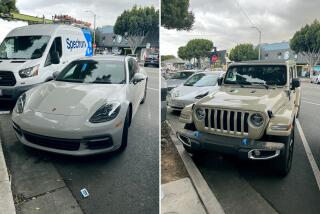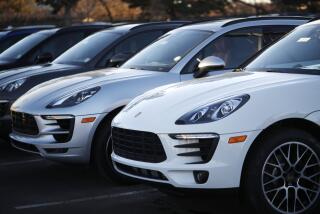Review: 918 Spyder is Porsche’s electrified future

The 918 Spyder is Porsche’s idea of a hybrid with 887 horsepower and costing $900,000.
- Share via
Porsche has seen the future of sports cars — and it’s electric.
The venerable German brand’s vision is embodied in its new 918, an 887-horsepower, $900,000 plug-in hybrid supercar. In addition to a V-8 that fears no redline, the 918 is packed with batteries, electric motors, regenerative brakes and super-light carbon-fiber body panels.
The result, says Porsche, is the fastest production car on Earth.
For six hours, we sampled Porsche’s future on lonely public roads several hours north of L.A. Beyond a neck-snapping zero-to-60-mph time of 2.5 seconds, the 918 carves curves with supreme confidence, thanks to active aerodynamics, all-wheel-drive and a center of gravity inches from the ground that conspires to keep this latest super-Porsche glued to the road.
The 918 Spyder matters to all future Porsche buyers, not just the 918 buyers of the 918. (Yes, that’s how many Porsche plans to sell.)
Call it trickle-down engineering. Porsche has already applied what it’s learned on the 918 project to other vehicles, including the new E-Hybrid version of the four-door Panamera. Porsche’s CEO has also confirmed in interviews that the next-generation 911 lineup will include a plug-in hybrid, and the next Boxster could have an all-electric variant.
Porsche isn’t the only brand flirting with melding high performance and green technology. This year, two more 21st century hybrid supercars hit the market. Ferrari’s LaFerrari and McLaren’s P1 each come with a seven-figure price tag, tiny production numbers and horsepower figures creeping toward 1,000.
The trio usher in a new era. No longer is a supercar propelled by only a massive gasoline engine crammed behind the driver and passenger, as was the case with Porsche’s last supercar, the 2004-07 Carrera GT. Today’s tighter emissions standards around the world mean high-performance brands can no longer disregard efficiency. Fortunately, the electrons also boost power, filling the gaps left by an internal combustion engine. Consider the powertrain in the Porsche 918.
The 4.6-liter, naturally aspirated V-8 thrives deep into its rev band; maximum horsepower comes at a screaming 8,700 rpm, just shy of its 9,150-rpm redline. (Try hitting 8,700 rpm in a Honda Civic, and all you’ll get is a roadside barbecue.)
Until now, that kind of power at the high end of the rev band often meant less power at the low end. But with a pair of electric motors — motors that have all of their torque available from a dead stop — Porsche can tune the 918 to provide power at any speed.
The 918’s grunt comes from three sources. The mid-mounted V-8 makes 608 horsepower and 398 pound-feet of torque on its own and lets out a high-pitched roar usually reserved for race tracks. The rear electric motor, making 156 horsepower, is sandwiched between the gas engine and the seven-speed, PDK dual-clutch transmission. It delivers power only to the rear wheels.
The front wheels get their own power source — 129 horses — from a second electric motor on the front axle. It comes on only when one of the car’s 50 computers notices that the rear wheels are slipping, or when the driver has the car in one of the more aggressive of the five drive settings.
This front motor also disconnects above 165 mph, though the gas and electric duo in the back of the 918 Spyder can keep it accelerating to a 214-mph top speed.
Packaging all this gear onto a single car wasn’t easy. The only thing visible at the back is a pair of short exhaust pipes pointing straight up, not unlike a Mack truck.
Layered underneath is a complex mashup of radiators, the gas engine, electric motor, transmission, rear axle, muffler and catalytic converters. The lithium-ion batteries and fuel tank sit directly behind the two passengers. All of this is bolted to a two-piece carbon-fiber chassis that splits the car in front and rear sections for major service.
From the driver’s seat, the complexity morphs into a seamless experience. The 918’s electronic wizardry melts into the background the harder you push it. You can hear the electric motors whir and whine over the V-8’s alto roar. All you sense is immense grip, power and balance.
The steering and the seats are purposefully firm, and the car’s structure is stiff, even with an open roof.
The 918 Spyder is more lively and visceral through turns than a Bugatti Veyron, which can feel cumbersome. But at 3,700 pounds, the Porsche isn’t light, and it feels less nimble than a McLaren P1.
The car’s biggest flaw is the brakes. Regenerative stoppers are tricky in any hybrid, and tend to feel spongy. So I don’t envy the Porsche engineers who were tasked with melding massive, 16-inch carbon ceramic disc brakes with a system that recaptures power at the same time. The brakes work, but they lack the firm, linear bite when approaching curves at triple-digit speeds.
The 918 Spyder runs in one of five modes, which the driver selects by turning a small knurled aluminum knob on the steering wheel.
The modes determine when and if the electric motors kick in, and with how much power if they do. The car starts up in full-electric E-Power mode — easily the most anticlimactic supercar start-up in the world.
Unfortunately, our prototype tester was cranky that day and wouldn’t run on electric power alone. This meant E-Power and Hybrid modes wouldn’t work (Hybrid mode runs either the engine or the motors but not both at the same time).
This left Sport Hybrid and Race modes. In these two progressively sharper settings, the engine is continuously running to both power the car and recharge the batteries. A final “Hot Lap” mode comes at the push of a red button on the steering wheel and is available only in short spurts. Here the electric motors sap all of the battery’s power, and the car is no longer concerned with keeping them charged.
In light of what Porsche packed into the 918 Spyder, the $845,000 base price seems reasonable. Still, a less advanced McLaren 650S or Ferrari 458 offers similar white-knuckle thrills at a third the price.
The 918 climbs past $900,000 with option packages, but Porsche didn’t build the car to make money. You don’t dive head first into the most technologically advanced project in company history looking to pinch pennies.
Porsche considers it an investment. It’s also a conspicuous way for the automaker to flex its technological muscles for customers and competitors alike.
This complex future of Porsche may bear little resemblance to its simple past. But the gilded crest will always seek speed. No matter where it comes from.
david.undercoffler@latimes.com







